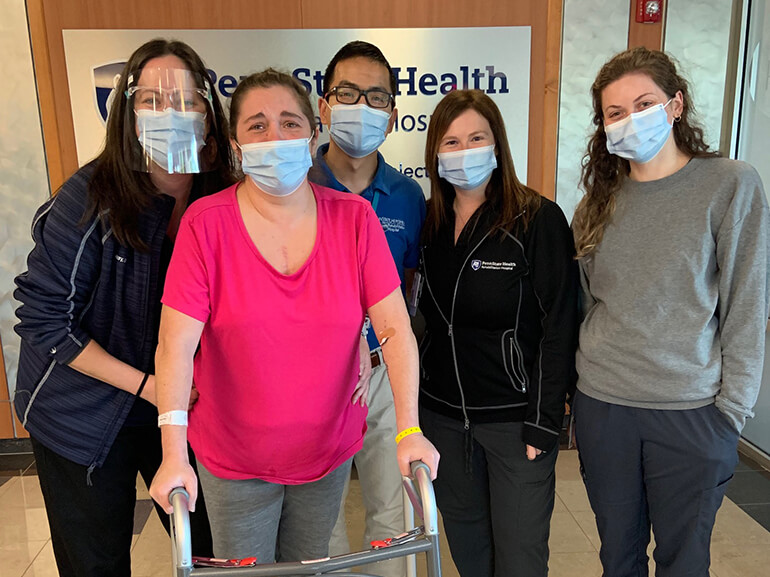Gina's story

“On March 28, my life changed forever. I fell down on the patio outside my home, unable to move my left side, unable to talk.” Gina Minneo, a 41-year-old, hardworking mother and grandmother, was found by her boyfriend and taken to Penn State Health Milton S. Hershey Medical Center. She was diagnosed with a right brain stroke and spent most of the next month in the hospital recovering. She was unable to move the left side of her body, talk and swallow safely. Once she was medically stable and ready for the next step in her recovery, Gina transferred to Penn State Health Rehabilitation Hospital.
When Gina arrived, she was dependent for all mobility, including rolling and sitting on the edge of the bed. She also had no torso control or strength in the left side of her body.
During the initial stage of therapy, Gina worked on sitting up in a tilt-in-space chair, which allowed her to physically tilt backward without changing the position of her body. This provided her with full assistance for maintaining a sitting position. She required the use of a mechanical lift to get in and out of the chair. Gina also worked on sitting tolerance, balance and torso control. She utilized an electrical stimulation bike to achieve movement in her left arm and left leg as well as to maintain her right leg strength. As she progressed, she moved to a standard wheelchair. It also helped her to start on transferring from on surface to another. She started transfers from her bed to wheelchair and her wheelchair to commode and bathroom shower seat.
Next, it was time to focus on walking. She required assistance of multiple people when she was first learning to walk. She began by standing with her right arm on a rail to assist her with her balance. As the strength improved in her hips and legs, she was be able to take steps at the rail. As the control in her left hand improved, she was able to transition to a rolling walker, with braces on both of her feet. The team worked on her endurance and strength in standing, and Gina improved to walking with a walker with close supervision, completing stairs with only steadying assistance and getting on and off the floor with limited assistance. This was all completed with the hopes of Gina being able to successfully transfer to a gardening bench at home.
In occupational therapy, Gina focused on being able to dress herself as well as complete bathing and hygiene tasks. Despite the limitations, she was very motivated to regain her independence. Gina worked on arm and hand exercises, using electrical stimulation for neuromuscular re-education. Her occupational therapists also used different activities to keep her treatment sessions interesting. They first worked on sitting followed by standing balance. She had very limited motion in her left arm at the start, but progressed to using her left, dominant arm to help with completing bathing/dressing tasks.
Gina’s speech therapists focused on fluency of speech and safe swallowing. Upon admission, her speech was unintelligible making it hard to understand her basic needs. Her speech was also low in volume and slurred. To help improve, Gina worked on breathing exercises and speech strategies. With enough practice, the team was able to understand her requests with minimal need for repetition. To help improve her ability to swallow safely, she performed exercises and utilized electrical stimulation to strengthen her swallowing muscles. Slowly but surely she progressed.
After six weeks at the rehabilitation hospital, Gina returned home able to complete most of her self-care tasks with independence. She went from not being able to sit up on her own, to walking out of the hospital using only a walker.
Gina planned to continue with the Penn State Health Rehabilitation Hospital outpatient day program to continue making gains upon discharge.